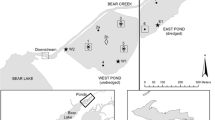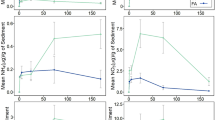Abstract
Low-grade weirs are innovative management strategies that control surface drainage, slow water velocities, and encourage sedimentation in agricultural drainage ditches. There is little information on how low-grade weirs perform in terms of short-term (0–12 months) sediment retention and associated phosphorus (P) dynamics. This study documents initial results of sediment and P dynamics of low-grade weirs in a drainage system that was built in a two-stage ditch design. Average sediment deposition did not differ significantly among sites (χ 2 = 2.42; P = 0.49); however, average water depths behind weir sites were significantly greater (28 ± 10 cm) than the comparison inflow site (6 ± 8 cm; χ 2 = 7.67; P = 0.05). Total P concentrations were not significantly different through time, or between sites, but there was a general trend of progressively higher total P retention moving downstream. Bioavailability ratios of P (i.e., the ratio of potentially bioavailable to non-bioavailable P fractions) were similar between all sites through time (χ 2 = 2.09; P = 0.55). The only variables correlated significantly with time were found at the inflow site, where water depth significantly decreased with corresponding increases in sediment/water column pH and bioavailability ratios. From best management practice installation to 12 months after construction, there was a lack of significant correlations with any measured variables behind weirs. However, the lack of correlation between variables suggests increasing the hydroperiod, reducing the ephemeral nature of the drainage ditch system, and prolonging inundation, improves conditions for P retention.









Similar content being viewed by others
References
Andersen, J. M. (1975). Influence of pH on release of phosphorus from lake sediments. Archiv für Hydrobiologie, 76(4), 411–419.
Baldwin, D. S., Mitchell, A. M. (2000). The effects of drying and re-flooding on the sediment and soil nutrient dynamics of lowland river-floodplain systems: a synthesis. Regulated Rivers: Research and Management 16, 457–467.
Blackwell, M. S. A., Brookes, P. C., de la Fuente-Martinez, N., Gordon, H., Murray, P. J., Snars, K. E., et al. (2010). Phosphorus solubilization and potential transfer to surface waters from the soil microbial biomass following drying–rewetting and freezing–thawing. In Donald, L. Sparks M. (Eds), Advances in agronomy (Vol. 106) (pp. 1–35). New York: Academic.
Blann, K. L., Anderson, J. L., Sands, G. R., & Vondracek, B. (2009). Effects of agricultural drainage on aquatic ecosystems: a review. Critical Reviews in Environmental Science and Technology, 39(11), 909–1001.
Bohn, H. L., McNeal, B. L., & O’Connor, G. A. (1979). Soil chemistry. New York: Wiley.
Boström, B., Andersen, J. M., Fleischer, S., & Jansson, M. (1988). Exchange of phosphorus across the sediment–water interface. Hydrobiologia, 170(1), 229–244.
Bowman R. A. (1988). A rapid method to determine total phosphorus in soils. Soil Science Society of America Journal 52, 1301–1304.
Bowmer, K. H., Bales, M., & Roberts, J. (1994). Potential use of irrigation drains as wetlands. Water Science and Technology, 29(4), 151–158.
Chacon, N., Flores, S., Gonzalez, A. (2006). Implications of iron solubilization on soil phosphorus release in seasonally flooded forests of the lower Orinoco River, Venezuela. Soil Biology and Biochemistry 38, 1464–1499.
Craft, C. B. (1996). Dynamics of nitrogen and phosphorus retention during wetland ecosystem succession. Wetlands Ecology and Management, 4(3), 177–187.
DeBolt, D. C. (1974). A high sample volume procedure for the colorimetric determination of soil organic matter. Communications in Soil Science and Plant Analysis, 5(2), 131–137.
Dunne, E. J., McKee, K. A., Clark, M. W., Grunwald, S., & Reddy, K. R. (2007). Phosphorus in agricultural ditch soil and potential implications for water quality. Journal of Soil and Water Conservation, 62(4), 244–252.
Fisher, J., & Acreman, M. C. (2004). Wetland nutrient removal: a review of the evidence. Hydrology and Earth System Sciences, 8(4), 673–685.
Hoffmann, C. C., Kjaergaard, C., Uusi-Kämppä, J., Hansen, H. C. B., & Kronvang, B. (2009). Phosphorus retention in riparian buffers: review of their efficiency. Journal of Environmental Quality, 38(5), 1942–1955.
House, W. A., Denison, F. H., & Armitage, P. D. (1995). Camparison of the uptake of inorganic phosphorus to a suspended and stream bed-sediment. Water Resources, 29(3), 767–779.
Jiang, C., Fan, X., Cui, G., & Zhang, Y. (2007). Removal of agricultural non-point source pollutants by ditch wetlands: implications for lake eutrophication control. Hydrobiologia, 581, 319–327.
Koski-Vähälä, J., Hartikainen, H., & Tallberg, P. (2001). Phosphorus mobilization from various sediment pools in response to increased pH and silicate concentration. Journal of Environmental Quality, 30(2), 546–552.
Kröger, R., Cooper, C. M., & Moore, M. T. (2008a). A preliminary study of an alternative controlled drainage strategy in surface drainage ditches: low-grade weirs. Agricultural Water Management, 95, 678–684.
Kröger, R., Holland, M. M., Moore, M. T., & Cooper, C. M. (2008b). Agricultural drainage ditches mitigate phosphorus loads as a function of hydrological variability. Journal of Environmental Quality, 37, 107–113.
Kröger, R., Lizotte, R. E. J., Shields, F. D. J., & Usborne, E. L. (2012a). Inundation influences on bioavailability of phosphorus in managed wetland sediments in agricultural landscapes. Journal of Environmental Quality, 41, 1–11.
Kröger, R., Moore, M. T., Farris, J. L., & Gopalan, M. (2011). Evidence for the use of low-grade weirs in drainage ditches to improve nutrient reductions from agriculture. Water, Air and Soil Pollution 221, 223–234.
Kröger, R., Moore, M. T., Thornton, K. W., Farris, J. L., Prevost, J. D., & Pierce, S. C. (2012b). Tiered on-the-ground implementation projects for Gulf of Mexico water quality improvements. Journal of Soil and Water Conservation, 67(4), 94A–99A.
Kuhnle, R. A., Bingner, R. L., Foster, G. R., & Grissinger, E. H. (1998). Land use changes and sediment transport in Goodwin Creek. In P. C. Klingeman, R. L. Beschta, P. D. Komar, & J. B. Bradley (Eds.), Gravel-bed rivers in the environment (pp. 279–292). Highlands Ranch: Water Resources Publications, LLC.
Loeb, R., Lamers, L. P. M., & Roelofs, J. G. M. (2008). Prediction of phosphorus mobilization in inundated floodplain soils. Environmental Pollution 156, 325–331.
Lucassen, E. C. H. E. T., Smolders, A. J. P., Lamers, L. P. M., & Roelofs, J. G. M. (2005). Water table fluctuations and groundwater supply are important in preventing phosphate-eutrophication in sulphate-rich fens: consequences for wetland restoration. Plant and Soil 269, 109–115.
MRBI (2012). Mississippi River Basin Healthy Watersheds Initiative fact sheet. http://www.nrcs.usda.gov/Internet/FSE_DOCUMENTS//nrcs143_008142.pdf. Accessed May 23 2012.
Murphy, R., & Riley, J. P. (1962). A modified single solution method for the determination of phosphate in natural waters. Analytica Chimica Acta, 27, 31–36.
Olila, O. G., Reddy, K. R., & Stites, D. L. (1997). Influence of draining on soil phosphorus forms and distribution in a constructed wetland. Ecological Engineering 9, 157–169.
Patrick, W. H. J., & Khalid, R. A. (1974). Phosphate release and sorption by soils and sediments: effect of aerobic and anaerobic conditions. Science 186, 53–55.
Petry, J., Soulsby, C., Malcolm, I. A., & Youngson, A. F. (2002). Hydrological controls on nutrient concentrations and fluxes in agricultural catchments. Science of the Total Environment, 294(1–3), 95–110.
Powell, G. E., Ward, A. D., Mecklenburg, D. E., & Jayakaran, A. D. (2007). Two-stage channel systems: part 1, a practical approach for sizing agricultural ditches. Journal of Soil and Water Conservation, 62(4), 277–286.
Puustinen, M., Tattari, S., Koskiaho, J., & Linjama, J. (2007). Influence of seasonal and annual hydrological variations on erosion and phosphorus transport from arable areas in Finland. Soil and Tillage Research, 93(1), 44–55.
Reddy, K. R., & DeLaune, R. D. (2008). Biogeochemistry of wetlands: Science and applications. Boca Raton: CRC.
Ruban, V., Lopez-Sanchez, J. F., Pardo, P., Rauret, G., Muntau, H., & Quevauviller, P. (1999). Selection and evaluation of sequential extraction procedures for the determination of phosphorus forms in lake sediment. Journal of Environmental Monitoring, 1, 51–56.
Ruban, V., Lopez-Sanchez, J. F., Pardo, P., Rauret, G., Muntau, H., & Quevauviller, P. (2001). Harmonized protocol and certified reference material for the determination of extractable contents of phosphorus in freshwater sediments—a synthesis of recent works. Fresenius’ Journal of Analytical Chemistry, 370, 224–228.
Schramm, H. L., Cox, M. S., Tietjen, T. E., & Ezell, A. W. (2009). Nutrient dynamics in the Lower Mississippi River Floodplain: comparing present and historic hydrologic conditions. Wetlands, 29(2), 476–487.
Sharpley, A. N. (1980). The enrichment of soil phosphorus in runoff sediments. Journal of Environmental Quality, 9, 521–526.
Sharpley, A. N., Krogstad, T., Kleinman, P. J. A., Haggard, B. E., Shigaki, F., & Saparito, L. S. (2007). Managing natural processes in drainage ditches for nonpoint source phosphorus control. Journal of Soil and Water Conservation, 62(4), 197–206.
Steiger, J., Gurnell, A. M., & Petts, G. E. (2001). Sediment deposition along the channel margins of a reach of the middle River Severn, UK. Regulated Rivers: Research & Management, 17(4–5), 443–460.
Surridge, B. W. J., Heathwaite, A. L., & Baird, A. J. (2007). The release of phosphorus to porewater and surface water from river riparian sediments. Journal of Environmental Quality, 36, 1534–1544.
Usborne, E., Littlejohn, K. A., Pierce, S. C., & Kröger, R. (2012). Nutrient reduction capabilities of agricultural drainage ditch wetlands: Creation and policy implications. In Wetlands: Ecology, management and conservation (pp. 185–202). New York: Nova.
USEPA (2002). Federal Water Pollution Control Act [As Amended through P.L. 107-303, November 27, 2002]. http://www.epa.gov/regulations/laws/cwa.html Last accessed (2/25/2011).
USEPA (2011). Managing nonpoint source pollution from agriculture—EPA841-F-96-004F. http://water.epa.gov/polwaste/nps/outreach/point6.cfm Last Accessed (1/27/2012).
Uusitalo, R., Turtola, E., Kauppila, T., & Lilja, T. (2001). Particulate phosphorus and sediment in surface runoff and drainflow from clayey soils. Journal of Environmental Quality, 30(2), 589–595.
Vaughan, R.E., Needelman, B. A., Kleinman, P. J. A., & Allen, A. L. (2007). Spatial variation of soil phosphorus within a drainage ditch network. Journal of Environmental Quality 36, 1096–1104.
Waters, T. (1995). Sediment in streams: Sources, biological effects, and control (Vol. 7). Bethesda: American Fisheries Society.
Watts, C. J. (2000). Seasonal phosphorus release from exposed, re-inundated littoral sediments of two Australian reservoirs. Hydrobiologia 431, 27–39.
Zaimes, G. N., Schultz, R. C., & Isenhart, T. M. (2004). Stream bank erosion adjacent to riparian forest buffers, row-crop fields, and continuously-grazed pastures. Journal of Soil and Water Conservation, 59, 19–27.
Zhang, M., He, Z., Calvert, D. V., & Stoffella, P. J. (2004). Spatial and temporal variations of water quality in drainage ditches within vegetable farms and citrus groves. Agricultural Water Management, 65(1), 39–57.
Acknowledgments
The authors would like to acknowledge the funding from the USDA-AFRI Seed Grant 2009-65107-05832 to Robert Kröger, as well as the MDEQ 319 fund for Harris and Porters Bayou. Installation of weirs at three locations within the ditch was funded through the Environmental Protection Agency’s, Mississippi Department of Environmental Quality, Clean Water Act Section 319 Nonpoint Source Management Program. Additional funding came from MRBI. The authors are also grateful to Melinda Josey for hel** in the phosphorus analyses and the Mississippi Agricultural Forestry and Experiment Station and the Forest and Wildlife Research Center for the support.
Author information
Authors and Affiliations
Corresponding author
Rights and permissions
About this article
Cite this article
Usborne, E.L., Kröger, R., Pierce, S.C. et al. Preliminary Evidence of Sediment and Phosphorus Dynamics Behind Newly Installed Low-Grade Weirs in Agricultural Drainage Ditches. Water Air Soil Pollut 224, 1520 (2013). https://doi.org/10.1007/s11270-013-1520-6
Received:
Accepted:
Published:
DOI: https://doi.org/10.1007/s11270-013-1520-6




